- Home
- Barbara W. Tuchman
The Zimmermann Telegram
The Zimmermann Telegram Read online
Barbara W. Tuchman
THE ZIMMERMANN TELEGRAM
America Enters the War, 1917–1918
Contents
Preface
1. A Telegram Waylaid
2. The Clever Kaiser and the Yellow Peril
3. “Seize the Customs House at Once!”
4. The Third Partner—Japan
5. “Von Rintelen Came Here, Backed by Millions …”
6. Viva Villa!—Made in Germany
7. “Our Friend Zimmermann”
8. The Trap
9. The Telegram Is Sent
10. “The Most Dramatic Moment in All My Life”
11. The Telegram in Washington
12. Obliged to Believe It
Author’s Note
Code Text of the Telegram
Notes
Sources
Follow Penguin
ABOUT THE AUTHOR
BARBARA W. TUCHMAN was a two-time recipient of the Pulitzer Prize and the author of numerous acclaimed works of history. Her titles include Bible and Sword, The Zimmermann Telegram, The Proud Tower, Notes from China, A Distant Mirror, Practicing History, The March of Folly, and The First Salute. She was awarded the Pulitzer Prize for General Nonfiction in 1963 for The Guns of August and again in 1972 for Stilwell and the American Experience in China.
Following her graduation from Radcliffe College in 1933, she took a position with the American Council of the Institute of Pacific Relations in Japan, where she also wrote for the Far Eastern Survey and Pacific Affairs. Upon her return to the United States, Tuchman began working for The Nation, and in 1937 she corresponded from Valencia and Madrid on the Spanish Civil War. She died in February 1989 and was survived by her husband, three daughters, and four grandchildren.
Preface
SINCE THIS BOOK WAS FIRST PUBLISHED, new information has become available affecting the cryptographic problem of the telegram, though not its historical and political circumstances, which stand as described.
A hitherto classified Signal Corps bulletin, “The Zimmermann Telegram of January 16, 1917 and Its Cryptographic Background” by William F. Friedman and Charles J. Mendelsohn (War Department, Office of the Chief Signal Officer, Washington, GPO, 1938) was declassified in 1965. Its primary author as Chief Cryptanalyst for the War Department, 1921–47, was the man responsible for breaking the Japanese code in 1941 and is America’s leading figure in cryptography. At the time of writing I knew of the existence of the bulletin, but despite application to Mr. Friedman, who remained kind but close-mouthed, I was unable to examine it or learn its gist. It now appears to modify my account by disclosing that a second German code, No. 0075, was involved in the telegram, with implications as regards decoding which are analyzed in a forthcoming book, The Codebreakers, by David Kahn, former president of the New York Cipher Society. The chief conclusion drawn from the new evidence is that decryptment of the message was accomplished to a greater degree by “solving” than by the help of a German code book or copy of the code in Room 40’s possession.
While venturing no dispute, I have retained in the following pages the stories suggesting a code copied by Szek or captured from Wassmuss because some measure of truth may yet lie buried in them and because the second story in particular was based on Admiral Hall’s own affidavit, as follows: “The German cipher book covering this system of ciphering is in our possession, it having been captured by the British authorities in the luggage of a German consul named Wasmuss [sic] who was stationed at Shiraz while Wasmuss was engaged in an endeavor to cut a British oil pipe line.” Friedman and Mendelsohn, reasonably enough, doubt that a diplomatic code book would have been entrusted to an agent like Wassmuss on his hazardous mission. Other new evidence, however, while supporting that doubt, now appears to confirm the story of a captured code book from the Persian Gulf.
Mr. C. J. Edmonds, who was Acting British Vice-Consul at Bushire on the Persian Gulf in 1915, was moved by the first appearance of this book to publish his own firsthand account of what took place there (“The Persian Gulf Prelude to the Zimmermann Telegram,” Journal of the Royal Central Asian Society, January, 1960). He relates that Wassmuss’ escape inspired the British staff at Bushire, including himself, to stage a thoroughly illegal arrest of the German Consul, Dr. Helmuth Listemann, and that among his effects, “wrapped up in several pairs of long woolen underpants,” were found “two ‘dictionary’ cyphers.” Mr. Edmonds writes that the interception of Wassmuss and raid on Listemann were “a single operation in two parts,” adding that, while the first was given publicity, the second “for obvious reasons” was not. Herein may lie the explanation of Admiral Hall’s affidavit. Since the arrest of Listemann was illegal he may have preferred to pass over it in silence and ascribe the finding of the cipher book, or books, to Wassmuss’ luggage instead. As we now know from the many recent accounts of World War II espionage, the truth often does not get into the record while the cover story does.
Progress in filming and classifying the German Foreign Office Archives captured after World War II has made possible a number of scholarly studies, since this book was written, on the German-Japanese peace negotiations of 1915–16 and the declaration of unrestricted submarine warfare of January, 1917. Among these are Gerhard Ritter’s Die Tragödie der Staatskunst: Bethmann Hollweg als Kriegskanzler 1914–17 (Munich, 1964); a French study of the captured documents by Andre Scherer and Jacques Grunewald, L’Allemagne et les problemes de la paix; Vol. I, Des Origines à la declaration de la guerre sous-marine à outrance, Août 1914–31—Janvier 1917 (Paris, 1962); and an article by Professor Frank W. Iklè, “Japanese-German Peace Negotiations During World War I,” American Historical Review, October, 1965. These add to, but do not essentially alter, what was known at the time I wrote.
The role of a minor official in the German Foreign Office, Legation Counselor von Kemnitz (first name unknown), as originator of the idea for the telegram has recently been confirmed by a German investigator, Dr. Friedrich Katz, in his Deutschland, Diaz und die mexikanische Revolution; die Deutsche Politik in Mexiko, 1870–1920 (Berlin, 1964). His researches have been made available to American readers by Professor Arthur S. Link in the fifth volume of his life of Wilson published in 1965. Although unmentioned by Dr. Katz, von Kemnitz’ role was first disclosed by Professor Moritz J. Bonn as reported in the German press in October, 1918, and subsequently referred to by von Kemnitz himself when he was candidate of the German People’s Party for election to the Reichstag in 1920. I did not include this rather shadowy figure in my account since the responsibility was in any case Zimmermann’s and since there was too little information on von Kemnitz to bring him into focus, and what there was was uncertain. He was variously described as a Far Eastern and a Latin-American specialist in the Foreign Office, a confusion which apparently persists because Dr. Katz calls him the one and Professor Link the other.
Dr. Katz makes the further point worth mentioning, that Zimmermann’s proposal was warmly endorsed by the ultimate authority in Germany at the time, as shown by the fact that the renewed offer of alliance, after the fiasco of the telegram, was brought to Mexico and presented to Carranza by a representative of the Supreme Command.
BARBARA W. TUCHMAN
May, 1966
One
A Telegram Waylaid
THE FIRST MESSAGE OF THE MORNING WATCH plopped out of the pneumatic tube into the wire basket with no more premonitory rattle than usual. The duty officer at British Naval Intelligence twisted open the cartridge and examined the German wireless intercept it contained without noting anything of unusual significance. When a glance showed him that the message was in non-naval code, he sent it in to the Political Section in the inner room and thought no more a
bout it. The date was January 17, 1917, past the halfway mark of a war that had already ground through thirty months of reckless carnage and no gain.
On duty that morning in the inner room, the most secret in Whitehall, were two civilians diverted to cryptographic work masked under the guileless name of Room 40. One was the Reverend William Montgomery, a tall gray-haired scholar of forty-six, and the other Nigel de Grey, a young publisher of thirty-one borrowed from the firm of William Heinemann. Neither knew they were about to midwife a historic event. De Grey spread open the intercept, revealing rows of numerals arranged in four- and five- and a sprinkling of three-figure groups. Mute and passive on the paper, they gave forth no hint that a key to the war’s deadlock lay concealed in their irregular jumble. De Grey noticed only that the message was of unusual length; more than a thousand groups, he estimated.
The gray morning was cold as Britain’s fortunes, dingy as her hopes in this third winter of the war. The ghastly losses on the Somme—sixty thousand British casualties in a single mad day, over a million Allied and enemy losses in the five-month battle—had been for nothing. The Hindenburg Line was still unbreached. The whole war had been like that, regiments of lives spent like water, half a million at Verdun alone, without either side’s winning a strategic advantage, but only being riveted together like two fighting elks who have locked horns. Now the French were drained, the Russians dying, Rumania, a late entry on the Allied side, already ruined and overrun.
The enemy was no better off. Germans were living on a diet of potatoes, conscripting fifteen-year-olds for the army, gumming up the cracks that were beginning to appear in the authority of Kaiserdom with ever harsher measures. The German offer a few weeks before to negotiate a peace had been a mere pretense, designed to be rejected so that the General Staff could wring from the home front and faltering Austria yet more endurance and more sacrifice. Room 40 suspected it must have an ulterior purpose, for there was no evidence so far that the German leaders were any less obstinately fixed on total victory than the Allies.
England had fortitude left, but no money and, what was worse, no ideas. New commanders stumbled forward in the old rut, not questioning whether to assault the Western Front again, but merely where along its wall to bang their heads. No prospect of any end was visible.
Montgomery and de Grey examined the close-packed groups of numerals they were supposed to transform into verbal intelligence, expecting no more than another piece in the prolix correspondence they had been intercepting lately between Berlin and Washington about a negotiated peace. This was President Wilson’s cherished goal. Bent on stopping the war, he quested after a compromise peace between mental blinkers, blind to both combatants’ utter unwillingness to compromise at all. Berlin kept him talking in order to keep him neutral. The talk exasperated the Allies. It was not mediation they wanted from America but her great, fresh, untapped strength. Nothing else could break the war’s deadlock. Arms, money, ships, men—everything the exhausted Allies needed was waiting in America, but Wilson would not budge. He remained unmoved behind his eyeglasses, lecturing both sides how to behave. It seemed there was nothing that would bring in the Americans before Europe exhausted itself beyond recovery.
De Grey’s eye caught the top group of numerals in the message, 13042, and recognized it as a variant of 13040, title number of the German diplomatic code. He pointed it out to Montgomery, who unlocked the safe and took from it a book which he handled as he might have a bottle labeled POISON! If there was no visible skull and crossbones on the book’s cover, there was more than one in its history, for the sea-bottom had been scraped and blood and life and honor spilled to assemble it. It was a reconstruction of the German code book for Code No. 13040. With it Montgomery took out another book that contained all that Room 40 had collected on the variants of the code. Through painstaking filing and collation of hundreds of intercepts, they had progressed toward a solution of the variants and so had built up a partially reconstructed key to use in cases like the present one.
The decoders tried first for the signature, which might give them a lead as to the nature of the message. A group in the 90000 range, 97556, appeared as the last group but two in the last row. High numbers such as this were usually reserved by the encoders for names or special words of infrequent use which were added as a supplement after the body of the code was made up. Working from earlier reconstructions in the code book, Montgomery and de Grey concentrated upon 97556. Obediently, as if tapped by a wand, it transformed itself into a name they knew well, “Zimmermann,” the German Foreign Secretary.
Going back to the beginning, they searched for the addressee, but instead of a name the first words to emerge were “Most secret,” and then they made out, “For Your Excellency’s personal information.” As the message was directed to Washington, the Excellency in question must be the German Ambassador there, Count von Bernstorff.
Routine so far, they were just about to decide, when an unexpected word appeared—“Mexico.” Wondering what the Germans could be saying about Mexico, they worked on with added interest, decoding the word “alliance” and farther on, to their astonishment, “Japan,” which was repeated in a phrase that came out as “us and Japan.” The decoders looked at each other with a wild surmise. Was it possible that Japan, one of the Allied powers, was changing sides? Urgently now they renewed the attack, their muttering dying away into concentrated silence as their scribbling speeded up. The code book pages flipped back and forth with an agitated rustle while sheets of paper filled up with words tested and discarded, with more words fitted together until, after two hours and in spite of many gaps in the sequence, an intelligible version had come clear.
It fell into two parts, for the intercept contained two separate telegrams. The first and longer one, addressed to Bernstorff, informed him of Germany’s intention to resume “unrestricted” submarine warfare on February 1, a decision expected and dreaded by the Allies for many months. “Unrestricted” meant that the U-boats were to be permitted to sink without warning all neutral as well as enemy merchant shipping found in the war zones. Bernstorff was instructed not to deliver the notice to the United States government until February 1, the very day the torpedoes would be let loose. Preparing for the belligerency that they believed would be America’s answer to the U-boat, the Germans had added another telegram. It consisted of 155 code groups and was headed, “Berlin to Washington. W 158. 16 January, 1917. Most Secret. For Your Excellency’s personal information and to be handed on to the Imperial Minister in Mexico by a safe route.”
The message for the Imperial German Minister in Mexico, Heinrich von Eckhardt, was headed “No. 1” and, in the incomplete version so far decoded, read:
We propose to begin on February 1 unrestricted submarine warfare. In doing this however we shall endeavor to keep America neutral … (?) if we should not (? succeed in doing so) we propose (? Mexico) an alliance upon the following basis: (joint) conduct of war, (joint) conclusion of peace … your Excellency should for the present inform the president* secretly (? that we expect) war with the U.S.A. (possibly) … (Japan) and at the same time negotiate between us and Japan … please tell the president that … our submarines … will compel England to peace within a few months. Acknowledge receipt. Zimmermann.
The significance of the message the decoders could hardly let themselves believe. Zimmermann had given Room 40 the lever with which to move the United States. Mexico was both America’s chief foreign investment area and chief trouble spot, where twice in the last three years American troops had gone in shooting and where, at that moment, twelve thousand men under General Pershing were deeply engaged. The United States was also exceedingly jumpy about Japan. In the circumstances, Zimmermann’s spectacular proposal, picked out of the endless whispering in the air, must surely dynamite the Americans out of their neutrality.
In the telegram there was a blank passage of thirty groups from which the decoders had been unable to pry any meaning whatever. They could not guess that
it contained the most explosive material of all. Only after weeks of patient, unrelenting effort were they able to reconstruct this portion of the code and discover that the missing passage contained Germany’s promise to assist Mexico “to regain by conquest her lost territory in Texas, Arizona, and New Mexico.”
Enough was at hand to require immediate action. This was a matter for the DNI, otherwise Admiral Hall, Director of Naval Intelligence. Montgomery hurried out of the room to fetch him. He returned, preceded through the door by a small ruddy man with authority in his step and an admiral’s gold stripes on his sleeve. The physical presence of Admiral Sir William Reginald Hall frequently nerved in men an impulse to do something heroic. For once de Grey, as he stood up and silently handed the scribbled sheets to the admiral, felt equal to the moment.
“Zimmermann, eh?” said Admiral Hall while his eyes darted over the pages. As he read, the intermittent eyelid twitch for which he was nicknamed “Blinker Hall” quickened, the compact little figure seemed, if possible, to stiffen, the brilliant blue eyes to blaze almost literally, and the tufts of white hair to bristle around the bald pink head until he looked like a demonic Mr. Punch in uniform.
Hall knew instantly that he held in his hands notice of what was at once a deadly peril and a possible miracle. Only the miracle of America’s entrance into the war could outweigh the peril of the unrestricted submarine, which, once let loose, might well accomplish what the Germans hoped—cut the Allies off from their source of supplies before the Americans had time to mobilize, train, and transport an army to help them. That was the stake the Germans were playing for.
Hall had known for months it would have to come to this, for the submarine was never designed for the gentlemanly role President Wilson seemed to think proper. To demand that it rise to the surface to warn before sinking, making itself a sitting duck in case its prey should shoot first, made nonsense of its function. He knew the Germans had accepted Wilsonian restrictions not because of the moral force of the President’s notes tapped out on his private typewriter, but only because they had not enough U-boats on hand to force the issue. Since then, he knew too, Kiel’s machine shops had been burning day and night, forging U-boats as fast as they could toward the goal of the two hundred Germany needed before letting loose a massive naval Verdun she hoped would bring Britain to her knees. Today’s telegram was the signal that the two hundred must be nearly ready.

 Practicing History: Selected Essays
Practicing History: Selected Essays Stilwell and the American Experience in China, 1911-45
Stilwell and the American Experience in China, 1911-45 Bible and Sword: England and Palestine From the Bronze Age to Balfour
Bible and Sword: England and Palestine From the Bronze Age to Balfour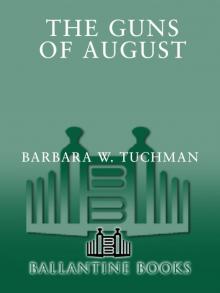 The Guns of August
The Guns of August The Proud Tower: A Portrait of the World Before the War, 1890-1914
The Proud Tower: A Portrait of the World Before the War, 1890-1914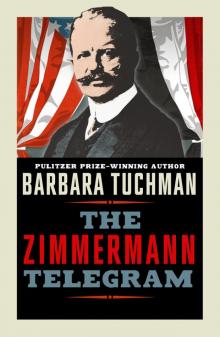 The Zimmermann Telegram
The Zimmermann Telegram A Distant Mirror: The Calamitous 14th Century
A Distant Mirror: The Calamitous 14th Century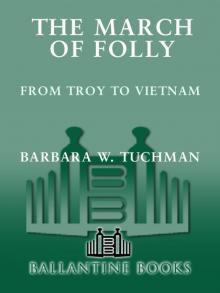 The March of Folly: From Troy to Vietnam
The March of Folly: From Troy to Vietnam The First Salute
The First Salute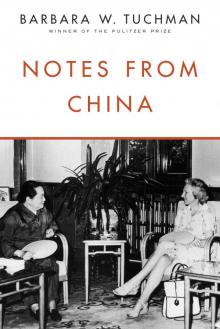 Notes From China
Notes From China Practicing History
Practicing History Stilwell and the American Experience in China
Stilwell and the American Experience in China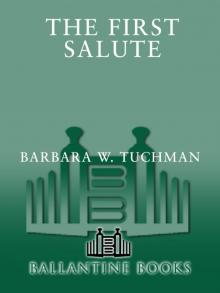 First Salute
First Salute Bible and Sword
Bible and Sword